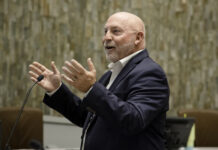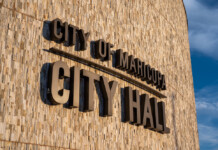
When the Pinal County Board of Supervisors voted to raise the primary property tax rate by 20 cents, it was not Anthony Smith’s idea.
Raising the tax rate, he said, should have been a last resort.
“As mayor (of Maricopa), raising the tax rate was the last, last option,” Smith said. “I could face the people of Pinal County a lot better if we do everything possible and not raise the tax rate.”
The District 4 supervisor, representing the Maricopa area, Smith said he feared the “unintended consequences” the action would cause among other taxing districts like cities and schools within the county.
“We’ve got a strategic plan that we would like to be able get the tax rate down at the state average (2.1779) at some particular point. And just from a whole host of economic development reasons, it appears as though (a tax increase) would be the wrong direction,” Smith said.
District 3 Supervisor Stephen Miller and Smith voted to keep the rate at 3.7999, but no one else did.
After hearing the impact more cuts would have on county departments and services, the board voted 3-2 to bump the rate back to $3.9999 per $100 net assessed value.
The county is facing an additional $4.6 million burden after the state Legislature shifted $45 million in costs to the counties to balance its budget.
The approved tax increase is expected to make up $4 million.
The biggest chunk of Pinal County’s budget impact from the state action comes from a 1 percent property tax cap liability shift. According to the County Supervisors Association of Arizona, the cap applies the Property Tax Oversight Commission’s interpretation of the law that uses statewide average property tax rates to determine which jurisdictions will be impacted.
On that score, only Pinal and Pima counties were hit, Pinal to the tune of $2.8 million.
“Since this state seems to be determined to penalize taxing districts above the state average, it really puts us in the wrong position that, if we continue to go up, takes us that much longer to get out of this penalty box,” Smith said.
Pima has the highest primary tax rate in the state at 4.2779. Pinal is third after Gila County. Pinal’s secondary rate is the fifth lowest, making the combined rate the fourth highest in Arizona.
Pinal was also one of only three counties impacted by additional loss of lottery revenue of $550,000. Yavapai and Mohave also had their lottery appropriations removed.
Pinal County already had 2 percent reductions in its budget. On top of the tax increase, the supervisors voted in April to cut the budget another 4 percent.
It was the lowest amount being considered and could have been as high as 7 percent, or a total of 9 percent when added to the previous cuts.
“Cuts that are too severe will result in less service to your constituents,” said Lynn Hurley, chief deputy for the clerk of the Superior Court. “It will result in longer delivery times and, most importantly, it would result in cutting off our ability to generate more revenue for the general fund.”
Sheriff Paul Babeu said just a 1 percent cut was equal to $250,000, but he and other department heads said they could live with the 4 percent reduction.
The possibility of even deeper cuts in county services swayed the majority of the supervisors toward the primary tax increase. Todd House, District 5, said cutting county services more would negatively affect economic development.
“Economic development in Pinal County is at an all-time high right now. We’ve never seen this kind of increase before in the history of Pinal County,” House said. “Why would I want to do something to endanger that? If you limit services even a little bit, if you make it more difficult to do business even a little bit, they will go somewhere else.”





![Elena Trails releases home renderings An image of one of 56 elevation renderings submitted to Maricopa's planning department for the Elena Trails subdivison. The developer plans to construct 14 different floor plans, with four elevation styles per plan. [City of Maricopa]](https://www.inmaricopa.com/wp-content/uploads/2024/04/city-041724-elena-trails-rendering-218x150.jpg)
![Affordable apartments planned near ‘Restaurant Row’ A blue square highlights the area of the proposed affordable housing development and "Restaurant Row" sitting south of city hall and the Maricopa Police Department. Preliminary architectural drawings were not yet available. [City of Maricopa]](https://www.inmaricopa.com/wp-content/uploads/2024/04/041724-affordable-housing-project-restaurant-row-218x150.jpg)

![City looks to lower property taxes again City Manager Ben Bitter speaks during a Chamber of Commerce event at Global Water Resources on April 11, 2024. Bitter discussed the current state of economic development in Maricopa, as well as hinting at lowering property tax rates again. [Monica D. Spencer]](https://www.inmaricopa.com/wp-content/uploads/2024/04/spencer-041124-ben-bitter-chamber-property-taxes-web-218x150.jpg)



![Alleged car thief released without charges Phoenix police stop a stolen vehicle on April 20, 2024. [Facebook]](https://www.inmaricopa.com/wp-content/uploads/2024/04/IMG_5040-218x150.jpg)




